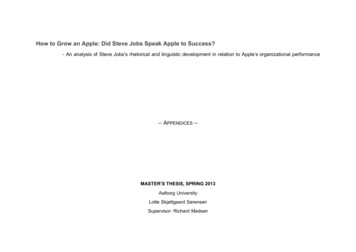
Transcription
“Coach Javorek has done so much for me and my career . I mean,he practically built me from scratch into an All-American.Without his wisdom and training techniques, there is no way Iwould be the same athlete I am today. He is the best!Wayne Simien – University of Kansas basketball playerMacDonald’s All-American”Istvan “Steve” JavorekBorn: Szekelyhid (Sacueni), Romania professor fitness and all-sports conditioning headcoach, Weightlifting Club head coachJohnson County Community College,Overland Park, Kansas, 1987-present USA College Strength and Conditioning Coaches Hall ofFamer USA Weightlifting Senior international coach Coach emeritus of Romania All-sports conditioning coach, track and field throwersand jumpers coach, head weightlifting coachTexas A&M, 1984-87 Weightlifting and conditioning head coachClujana Athletic Club-Cluj, Romania, 1964-82 Coached athletes of junior and senior Romanianweightlifting national teams, 1975-82 Head coach at the U.S. Olympic Festival forWeightlifting, 1986-87 1983 - Coach of South Korean Weightlifting Team byinvitation of South Korean Olympic Committee 1984 - Two weeks lecture tour delegated by theU.S.Olympic Committee, at Lima, Peru 1989 World Junior Weightlifting Championship USWFteam assistant coachMajor Performances Coached: Dragomir Cioroslan, Romania – U.S.W.F. residenceprogram head coach, 1984 L.A. Olympic Games, bronzemedal Istvan Tasnadi, Romania – 1984 L.A. Olympic Games,silver medal Randy Barnes at Texas A&M, world-record holder,silver medallist in shot put, 1988 Seoul OlympicGames; gold medal and Olympic champion in shot put,1996, Atlanta, Georgia, Summer Olympic Games Ian James, Canada, long jump, at Texas A&M Juan de la Garza, Mexico, javelin, at Texas A&M Wesley Barnett, 1992-99 USA National Weightliftingchampion; sixth place at 1996 Atlanta, Georgia,Summer Olympic Games; 1996 athlete of the year Jim Dice, Larry Dice, Dirk Yasko, members of the USWFnational squad, national junior and collegiatechampions Coach of 1987,1988, 1989, 1991 National CollegiateWeightlifting Team championship with University ofTexas A&M (1987) and Johnson County CommunityCollege“Coach Istvan Javorek inspired me as a high school athlete to workhard in the weight room as well as on the basketball courtKareem Rush – LA Lakers shooting guard“Javorek’s ideas have had the greatest influence on my philosophyand training of any individual in 30 years of work in this field.Fred Roll – Sports Conditioning Specialist””“I have used Istvan “Steve” Javorek’s training methods, especiallythe complex exercises, and have found them to be an asset toour program.Al Vermeil – Strength and Conditioning Coach, Chicago Bulls”“We have found Istvan Javorek's methods to be practical,functional and advantageous to improving athletic performance.We have implemented his methods with athletes for numerousyears and have attained remarkable results. We highlyrecommend studying his training methods for athletes of allages. You will undoubtedly improve your performance.Mike Clark and Allen Kinley – Associate Head CoachStrength and Conditioning, Texas A&M”“Javorek's dumbbell training programs are the best innovation tohit strength training since the barbell. You are only limited byyour imagination and the results are fantastic.Rob Rogers – M. Ed., C.S.C.S. Football Conditioning CoachMiddle Tennessee State University“As a police officer, it is very important to have excellent overallcondition. Over the years, I have trained many ways, includingthe traditional police methods to gain strength and condition.Nothing has produced strength and condition gains like theprograms developed by Coach Javorek.Sergeant Geno DeAngelo – Binghamton police department””“There is no drug on the planet that can make a 19-footimprovement happen in 8 months I was transformed. CoachJavorek was the catalyst behind this transformation.Randy Barnes – Shut Put Indoor and Outdoor World-RecordHolder, 1988 Olympic Silver, 1996 OlympicGold Medallist“Coach Javorek’s workouts give me the confidence in the ring inthe very demanding sport of boxing. His programs keep mestrong and in the best cardiovascular condition.Sumya Anani – IBA Lightweight World ChampionGBU 143lb. World Champion””“Coach Javorek’s enormous knowledge of strength and techniquehelped lay the groundwork for my future success. I was able totake the knowledge I gained from him and use it over the courseof my career.Wesley Barnett – 7 times USA national champion, 1996 athleteof the year, 1992,1996 USA Olympic Team,1997 World Championships Silver medallist”
Table of ContentsAcknowledgments .4Chapter 1Introduction .5Chapter 2Weightlifter or Weight Trainer?.9Chapter 3A Brief History of Weightlifting and Sports Conditioning.11Chapter 4Physical Appearance of the Weightlifter.14Chapter 5Weightlifting as a Conditioning Tool .16Chapter 6Planning the Training Program.18Chapter 7Overtraining and Restoration .19Chapter 8Specificity In Sports Conditioning.25Chapter 9Drug-free Physical Preparation in Sport.29Chapter 10Warming Up.31Chapter 11 Plyometrics in Theory and Practice .34Chapter 12 Dumbbells or Machines in General Sports Conditioning?.55Chapter 13 Combined Dumbbell and Barbell Training.63Chapter 14 Dumbbell Programs.71Chapter 15 Dumbbell and Barbell Circuit Conditioning.73Chapter 16 Javorek’s General Fitness Conditioning # 1 .88Chapter 17 Javorek’s General Bodybuilding # 1 Training .101Chapter 18 Javorek’s Dumbbell General Fitness # 2 Training .113Chapter 19 Javorek’s 12 Week Dumbbell Body Building # 2 Training.123Chapter 20 Javorek’s Barbell Body Building # 1 Training.133Chapter 21 Javorek’s Mesocycle Conditioning Program # 1 .145Chapter 22 Javorek’s Mesocycle Conditioning Program # 2.154Chapter 23 Javorek’s Introduction to “Big Fun” Training.162Chapter 24 Javorek’s “Big Fun” Program.172Chapter 25 Javorek’s Millennium Elite Athletes “Tremendous Pleasure” Conditioning Program.181Chapter 26 Barbell Exercise Classification and Description.196Chapter 27 Philosophy and Techniques of Weightlifting.205Chapter 28 Javorek’s 24 Weeks Weightlifting Programs.212Chapter 29 Javorek’s Four Days a Week Weightlifting Programs.234Chapter 30 General Weight Training for Wheelchair Athletes.242Chapter 31 Exercising at Your Desk .244Chapter 32 Javorek’s Wrist Shoulder Back Ankle and Leg Injuries Athletic Reconditioning Programs.247Chapter 33 Outline For A Weight Training Class.2543
Chapter 7Overtraining and RestorationIn modern athletics and general fitness, the concept of conditioning has changed enormouslyduring the last few decades, but the basic rule of improvement has remained the same, namelythe imposition of optimal stimulation, and the avoidance of overloading. Without stimulating theneuromuscular and musculoskeletal systems correctly, the intendedimprovements and anticipated results will not show up at all or will doso at a lower level. At the same time working out at excessive intensity could fatigue the athlete and lead to different degrees of overtraining.In modern scientific conditioning we like talking about a year-roundpreparation, but we make the biggest mistake if we ignore varyinglong-term organization or periodization of the loading. What I nowrefer to, as periodization of the yearly plan of preparation is fundamental to all sport and even many daily activities. It does not matter ifI am talking about Weightlifting preparation or conditioning for allsports; the concept of a varying cyclical preparation is necessary andvery important. The huge load of today’s workouts and the year-roundpreparation of course produces its own consequences. Well-plannedpreparation optimizes adaptation and produces good results, whereaspoorly planned or haphazard preparation leads to inadequate performance or overtraining.What is recovery and why is it so important?I might state that recovery means to quickly regain one hundred percent of physical, intellectual and psychological capacity, so that theathlete can begin a new workout or other activity with complete power,full capabilities and skillfulness. The other very similar word used inathletics is restoration, where the Webster Dictionary defines restorative as “capable of restoring one’s health or strength”, although in competitive sport, one would say that health and strength both need to berestored. Thus, restoration should be an important part of the overallprogram and intimately associated with functioning of the neuropsychological, neuromuscular, metabolic and cardio-respiratory systemsof the body. Restoration can be general, but at the same time individualized. It has particularities in concordance with each workout, theperiodization of preparation and adaptation to the progressivelyincreasing effort. Restoration is a natural process dependent on theneuro-endocrine system, and it has to form an integral part of preparation, regardless of the different phases of training. Less work needs lessrestoration, which of course results in poor athletic performances.In accordance with the rules of organized conditioning, we have tofollow up our athletes’ preparation level and health and personal problems, which can positively or negatively influence their restoration.Furthermore, you cannot use the same methods of restoration duringthe preparatory, competition and transitory phases, nor even the samemethods between workouts. In the preparatory phase, one needs toconcentrate more on physical restoration; and in the competitionphase more on psychological restoration (though not neglecting physical restoration). The transition phases should offer complete physicaland psychological restoration.I would like to accentuate my idea of recovery and restoration with avery simple example. One two-hour workout per day, 3-4 times aweek is not the same as working out 2-3 times a day, six days perweek. Assuming 100% recovery in both cases, it would take a month’sworth of once-a-day workouts to equal the load generated in just aweek of working out 2-3 times per day. This means that in an Olympiccycle (4 years of 36 hours weekly preparation), the multi-workout perday athlete is doing as much in a single year as the other is doing inall four! You can achieve this goal by proper use of restoration andrecov
worth of once-a-day workouts to equal the load generated in just a week of working out 2-3 times per day. This means that in an Olympic cycle (4 years of 36 hours weekly preparation), the multi-workout per day athlete is doing as much in a single year as the other is doing in all four! You can achieve this goal by proper use of restoration and











